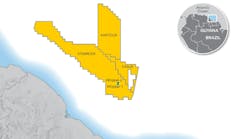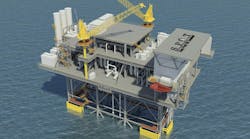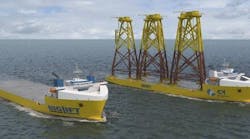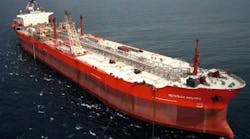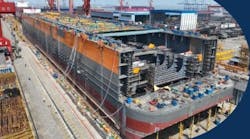Vietnam has moved up to become Southeast Asia's fourth largest oil and gas producer, and is implementing plans to stay in the top five and possibly even move higher. The country ranks behind Indonesia, Malaysia and Brunei. Vietnam hopes to increase output to 20 million tons per year and to quadruple gas output to 4 bcf.
The country's ranking is primarily due to VietsovPetro, the early oil and gas joint-venture with Russia, whose White Tiger and Nine Dragons fields contribute 80% of oil output and 100% of gas production. However, PetroVietnam, the country's state oil company, is moving to assure production from other areas. The company expects to increase the number of production sharing contracts (PSC). About 50 companies are involved in PSCs. Future PSCs will focus primarily on areas in the Tonkin Gulf in the 2000-2010 period.
OMV (Vietnam) Exploration and Edison International are the latest to sign a PSC with PetroVietnam, covering exploration and development of Block 111 in the Red River Basin off the country's central coast of the Ha Tinh and Quang Binh provinces. Each company holds a 50% stake in the PSC. The companies plan to begin exploration in 2001. Additional PSC are expected to be signed in the near future.
Conoco's Vietnam Block 15-1 flowed at a record rate of 17,800 b/d from the block's first exploratory well in the Cuu Long Basin. The flow rate is based on combined well tests of more than 12,600 b/d from three zones and an additional estimated 5,200 b/d from three other zones. Conoco is planning an additional exploratory well and an appraisal well on the block during the first quarter of 2001. Conoco is also operator on Block 16-2, which is currently undergoing 3D seismic survey.
It is expected that the 60 bcm Lan Tay-Lan Do gas well in the Nam Con Son oilfield will be developed in 2002 when a pipeline to the Phu My power plan in Ba Ria-Vung Tau province is complete. PetroVietnam also expects to produce gas from the Bungakewa well in the southwestern region in 2003 and in other areas including Lots 46, 50, 51-B and 52-97, with an estimated output of 2.5 Bcm of gas.
CNOOC plans development of Beibu Gulf field
China National Offshore Oil Corp. (CNOOC) plans to develop the DF1-1 gas field via a central platform, three wellhead platforms and a processing terminal with annual capacity of 2.4 bcm. First phase of the project is expected on stream in September 2004. The field was discovered in 1992 in the Beibu Gulf of the South China Sea and covers a gas-bearing area of nearly 288 sq km. Located next to the Yacheng gas field, it was reported to have proved geological reserves of 99.68 bcm of gas in 1996.
Kerr-McGee awarded Bohai Bay block
CNOOC awarded Kerr-McGee Block 09/18 in Bohai Bay. The block includes more than 550,000 acres and is in 65 ft of water south of the company's Blocks 04/36 and 05/36. Kerr-McGee confirmed a third oil field in Bohai Bay in August and began a seismic survey in Block 04/36 to determine its size and adjacent prospects.
Indonesia incentives for marginal fields
Indonesia plans to offer incentives to encourage companies to invest in marginal oilfields as output from its older fields has declined. The fields could add 300,000 b/d to the country's current production. The Department of Mines and Energy said the country needs from three to six months to meet its new OPEC quote of 1.36 million b/d and is going to have to fully use its marginal fields to meet the quota.
The types of incentives are expected to be determined late this year or early 2001. The types of incentives could include a larger share for the operator, an investment tax credit, or possibly relieve the obligation to sell oil to the government at low prices. Incentives will apply only to marginal fields and are expected to be determined on a field-by-field basis.
Meantime, several new gas discoveries and significant spending by BP are in the works in Indonesia. BP plans to spend $2 billion to develop oil and gas fields in the country, the Tangguh field in particular. The company said Tangguh holds more than 20 tcf of high quality gas reserves. The company also plans to build an LNG receiving terminal in Shenzhen near Hong Kong with the intention of supplying gas from the field to China if it receives a contract. China is trying to increase its use of natural gas to supply energy needs.
Among gas discoveries, Premier Oil made a recent discovery adjacent to its West Natuna development project in the Natuna Sea. The Gajah Baru-1 well in the Arang formation flowed from eight separate reservoirs. The gas may be transferred through the West Natuna pipeline to Singapore or to the Malaysian Duyong platform 220 miles west of the discovery. This is the fourth successful well drilled by Premier in the West Natuna area this year.
Additionally, Devon Energy completed the wildcat KOI-1 off Irian Jaya. The well tested at combined rates of 900 b/d of oil and 2.5 MMcf/d of gas from two intervals.
Apache Australia well reports encouraging
Apache's Chamois-1 wildcat in the WA-261-P permit off Western Australia was being prepared for production testing after shows were recorded encountering a 193 meter interval. Initial estimates regarding the Chamois-1 well are between 25-50 million bbl. The well is 5 km updip from the Oryx-1 oil discovery and adjacent to the Apache-operated WA-209-P permit, which holds the 45 million bbl Stag field.
Apache is also operator of the Tusk-1 discovery well in the WA-246-P permit off Western Australia. The well is five km north of the Oryx-1 and 20 km west of the Stag field. The well was drilled to a depth of 2,020 meters in the Athol formation. Oil was recovered from wireline samples at 1,166 meters and 1,217 meters. The well was plugged back to 1,090 meters for sidetracking. Tap Oil NL, one of the partners, said a development decision would likely be in association with the Oryx discovery and may be tied back to the Stag field.
Timor Sea well has oil shows
Indo-Pacific Energy says that the Coleraine-1 well in the Timor Sea permit ZOCA 96-16, operated by Phillips, has indications of oil at a minor objective at about 8,000 ft. Phillips is preparing to evaluate the well. The major objectives of the well are situated below 10,000 ft.
Wenchang development underway
Husky Oil China Ltd. said it signed a contract to jointly develop the Wenchang 13-1 and 13-2 oil fields in the South China Sea with China National Offshore Oil Corp.
Discovered in 1997, the Wenchang oil field development is located about 136 km east of Hainan Island in 100 meters water depth. Development work has begun.
"Oil production from Wenchang is targeted to begin in the first half of 2002 and have a peak production rate of 50,000 b/d of oil. Independent consultants have estimated recoverable reserves at approximately 100 MMbbl for the two fields," James S. Blair, Husky Energy Senior Vice President, said.
The group has approached contractors regarding the construction of a 1.2 MMbbl-capacity FPSO located between the two fields. Husky will hold a 40% working interest in the CNOOC-operated fields.
